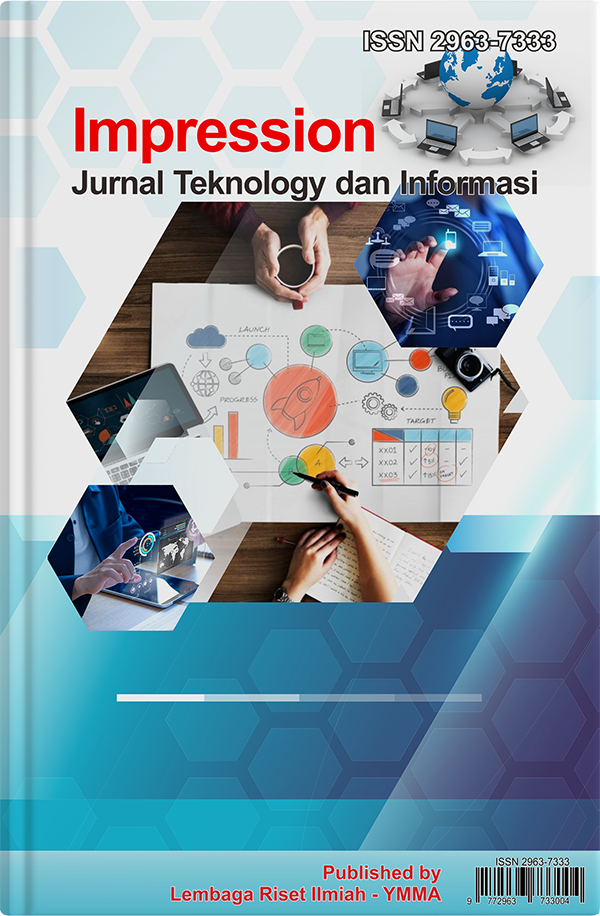Analisis Performa Metode Logistic Regression dalam Memprediksi Suhu Panel Surya Model Terapung Berbasis Arduino
DOI:
https://doi.org/10.59086/jti.v4i2.1056Keywords:
Metode Logistic Regression, Prediksi Suhu Panel, Panel Surya Terapung, Arduino Uno, Konversi EnergiAbstract
Energi surya merupakan salah satu sumber energi terbarukan dengan potensi besar di Indonesia karena letak geografisnya yang berada di daerah tropis dengan intensitas cahaya matahari tinggi sepanjang tahun. Namun, panel surya konvensional masih menghadapi kendala, seperti fluktuasi cuaca, perubahan posisi matahari, serta suhu berlebih pada sel surya yang menurunkan efisiensi konversi energi. Mengatasi hal ini, penelitian ini mengusulkan sistem panel surya terapung berbasis Arduino Uno. Metode Logistic Regression (LR) digunakan untuk memprediksi performa konversi energi dengan mempertimbangkan intensitas cahaya matahari dan suhu sel surya. Hasil evaluasi menggunakan Metode Logistic Regression (LR) dalam memprediksi suhu permukaan sel surya menunjukkan akurasi model sebesar 93,3%. Berdasarkan confusion matrix, pengujian diperoleh data precision 97% dan recall 95% dengan f1-score 0,96. Nilai macro average (precision 0,88, recall 0,91, f1-score 0,90) dan weighted average (precision 0,94, recall 0,93, f1-score 0,93), model bekerja sangat baik meskipun masih perlu perbaikan dalam mengenali kelas minoritas. Kemudian data pengujian konversi energi pada grafik daya panel menunjukkan fluktuasi seiring perubahan intensitas cahaya antara pukul 11:00 hingga 13:00 WIB, dengan daya puncak 114,2 Wp. Secara keseluruhan, sistem terbukti mampu menghasilkan daya listrik stabil dan optimal, sehingga potensial diterapkan untuk mendukung penyediaan energi berkelanjutan.
Solar energy is a renewable energy source with great potential in Indonesia due to its geographical location in tropical areas with high sunlight intensity throughout the year. However, conventional solar panels still face obstacles, such as weather fluctuations, changes in the sun's position, and excessive temperatures on solar cells that reduce energy conversion efficiency. To overcome this, this study proposes a floating solar panel system based on Arduino Uno. The Logistic Regression (LR) method is used to predict energy conversion performance by considering sunlight intensity and solar cell temperature. The evaluation results using the Logistic Regression (LR) method in predicting solar cell surface temperature show a model accuracy of 93.3%. Based on the confusion matrix, the test obtained 97% precision and 95% recall data with an f1-score of 0.96. The macro average value (precision 0.88, recall 0.91, f1-score 0.90) and weighted average (precision 0.94, recall 0.93, f1-score 0.93), the model works very well although it still needs improvement in recognizing minority classes. Energy conversion test data on the panel power graph then showed fluctuations with changes in light intensity between 11:00 AM and 1:00 PM WIB, with a peak power of 114.2 Wp. Overall, the system has proven capable of producing stable and optimal electrical power, making it potentially applicable to support sustainable energy provision.
References
Adrianti, Agung, T. K., Nasir, M., & Anugrah, P. (2023). A 48-MW floating photovoltaic design and integration to a grid. Indonesian Journal of Electrical Engineering and Computer Science, 30(3). https://doi.org/10.11591/ijeecs.v30.i3.pp1331-1338
Al Azhima, S. A. T., Darmawan, D., Arief Hakim, N. F., Kustiawan, I., Al Qibtiya, M., & Syafei, N. S. (2022). Hybrid Machine Learning Model untuk memprediksi Penyakit Jantung dengan Metode Logistic Regression dan Random Forest. Jurnal Teknologi Terpadu, 8(1). https://doi.org/10.54914/jtt.v8i1.539
Alsagri, A. S. (2022). Photovoltaic and Photovoltaic Thermal Technologies for Refrigeration Purposes: An Overview. In Arabian Journal for Science and Engineering (Vol. 47, Issue 7). https://doi.org/10.1007/s13369-021-06534-2
Anand, B., Shankar, R., Murugavelh, S., Rivera, W., Midhun Prasad, K., & Nagarajan, R. (2021). A review on solar photovoltaic thermal integrated desalination technologies. In Renewable and Sustainable Energy Reviews (Vol. 141). https://doi.org/10.1016/j.rser.2021.110787
Cazzaniga, R., Cicu, M., Rosa-Clot, M., Rosa-Clot, P., Tina, G. M., & Ventura, C. (2018). Floating photovoltaic plants: Performance analysis and design solutions. In Renewable and Sustainable Energy Reviews (Vol. 81). https://doi.org/10.1016/j.rser.2017.05.269
Dai, J., Zhang, C., Lim, H. V., Ang, K. K., Qian, X., Wong, J. L. H., Tan, S. T., & Wang, C. L. (2020). Design and construction of floating modular photovoltaic system for water reservoirs. Energy, 191. https://doi.org/10.1016/j.energy.2019.116549
Dreiseitl, S., & Ohno-Machado, L. (2002). Logistic regression and artificial neural network classification models: A methodology review. Journal of Biomedical Informatics, 35(5–6). https://doi.org/10.1016/S1532-0464(03)00034-0
Gul, M., Kotak, Y., & Muneer, T. (2016). Review on recent trend of solar photovoltaic technology. Energy Exploration and Exploitation, 34(4). https://doi.org/10.1177/0144598716650552
Gunawan, M. I., Sugiarto, D., & Mardianto, I. (2020). Peningkatan Kinerja Akurasi Prediksi Penyakit Diabetes Mellitus Menggunakan Metode Grid Seacrh pada Algoritma Logistic Regression. Jurnal Edukasi Dan Penelitian Informatika (JEPIN), 6(3). https://doi.org/10.26418/jp.v6i3.40718
Gusti, K. W. (2023). Perbandingan Metode Support Vector Machine dan Logistic Regression untuk Klasifikasi Bencana Alam. Informatik : Jurnal Ilmu Komputer, 19(2). https://doi.org/10.52958/iftk.v19i2.6355
Hermoso, V., Bota, G., Brotons, L., & Morán-Ordóñez, A. (2023). Addressing the challenge of photovoltaic growth: Integrating multiple objectives towards sustainable green energy development. Land Use Policy, 128. https://doi.org/10.1016/j.landusepol.2023.106592
Li, P., Gao, X., Li, Z., & Zhou, X. (2022). Effect of the temperature difference between land and lake on photovoltaic power generation. Renewable Energy, 185. https://doi.org/10.1016/j.renene.2021.12.011
Liu, Z., Jin, Z., Li, G., Zhao, X., & Badiei, A. (2022). Study on the performance of a novel photovoltaic/thermal system combining photocatalytic and organic photovoltaic cells. Energy Conversion and Management, 251. https://doi.org/10.1016/j.enconman.2021.114967
Marques Lameirinhas, R. A., Torres, J. P. N., & de Melo Cunha, J. P. (2022). A Photovoltaic Technology Review: History, Fundamentals and Applications. In Energies (Vol. 15, Issue 5). https://doi.org/10.3390/en15051823
Mungkin, M., Satria, H., Maizana, D., Isa, M., Syafii, & Puriza, M. Y. (2023). Analysis of the feasibility of adding a grid-connected hybrid photovoltaic system to reduce electrical load. International Journal of Power Electronics and Drive Systems, 14(2). https://doi.org/10.11591/ijpeds.v14.i2.pp1160-1171
Pastuszak, J., & Węgierek, P. (2022). Photovoltaic Cell Generations and Current Research Directions for Their Development. In Materials (Vol. 15, Issue 16). https://doi.org/10.3390/ma15165542
Pimentel Da Silva, G. D., & Branco, D. A. C. (2018). Is floating photovoltaic better than conventional photovoltaic? Assessing environmental impacts. Impact Assessment and Project Appraisal, 36(5). https://doi.org/10.1080/14615517.2018.1477498
Rahaman, M. A., Chambers, T. L., Fekih, A., Wiecheteck, G., Carranza, G., & Possetti, G. R. C. (2023). Floating photovoltaic module temperature estimation: Modeling and comparison. Renewable Energy, 208. https://doi.org/10.1016/j.renene.2023.03.076
Santoso, A. K. S., Noviriandini, A., Kurniasih, A., Wicaksono, B. D., & Nuryanto, A. (2021). KLASIFIKASI PERSEPSI PENGGUNA TWITTER TERHADAP KASUS COVID-19 MENGGUNAKAN METODE LOGISTIC REGRESSION. Jurnal Informatika Kaputama (JIK), 5(2). https://doi.org/10.59697/jik.v5i2.247
Sutanto, B., Iacovides, H., Nasser, A., Cioncolini, A., Afgan, I., Indartono, Y. S., Prasetyo, T., & Wijayanta, A. T. (2024). Design and analysis of passively cooled floating photovoltaic systems. Applied Thermal Engineering, 236. https://doi.org/10.1016/j.applthermaleng.2023.121801
Tina, G. M., & Bontempo Scavo, F. (2022). Energy performance analysis of tracking floating photovoltaic systems. Heliyon, 8(8). https://doi.org/10.1016/j.heliyon.2022.e10088
Tina, G. M., Cazzaniga, R., Rosa-Clot, M., & Rosa-Clot, P. (2018). Geographic and technical floating photovoltaic potential. Thermal Science, 22. https://doi.org/10.2298/tsci170929017t
Treviño Rodríguez, K., Sánchez Vázquez, A. I., Ruiz Valdés, J. J., Ibarra Rodríguez, J., Paredes Figueroa, M. G., Porcar García, S., Carda Castelló, J. B., & Álvarez Méndez, A. (2023). Photovoltaic Glass Waste Recycling in the Development of Glass Substrates for Photovoltaic Applications. Materials, 16(7). https://doi.org/10.3390/ma16072848
Yao, H., & Zhou, Q. (2023). Research status and application of rooftop photovoltaic Generation Systems. In Cleaner Energy Systems (Vol. 5). https://doi.org/10.1016/j.cles.2023.100065
Yun, H. (2021). Prediction model of algal blooms using logistic regression and confusion matrix. International Journal of Electrical and Computer Engineering, 11(3). https://doi.org/10.11591/ijece.v11i3.pp2407-2413
Zhang, C., Dai, J., Ang, K. K., & Lim, H. V. (2024). Development of compliant modular floating photovoltaic farm for coastal conditions. Renewable and Sustainable Energy Reviews, 190. https://doi.org/10.1016/j.rser.2023.114084
Downloads
Published
How to Cite
Issue
Section
License
Copyright (c) 2025 Fajar, Habib Satria

This work is licensed under a Creative Commons Attribution 4.0 International License.
Impression Jurnal Teknologi dan Informasi
Publisher Lembaga Riset Ilmiah

This work is licensed under a Creative Commons Attribution 4.0 International License.













